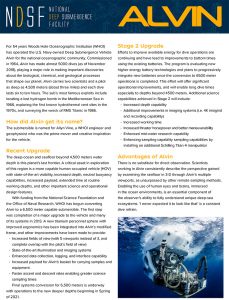Dive with Alvin
Human presence, direct observation, precision sampling
Fact Sheet
Alvin 360 Tour
Inside the Alvin sphere
Take a 360 tour inside the sphere where researchers and the Alvin pilot sit while exploring the deep sea.
HOV Alvin
An Alvin-based research expedition delivers a firsthand experience unlike any other in science: it allows in-situ data collection and observation by two scientists of the seafloor and water column to depths reaching 6,500 meters on dives lasting up to twelve hours, with the support of an experienced, multi-disciplinary technical team. The Alvin Group and their equipment meet the highest safety and reliability standards as a result of decades of operational and engineering expertise and U.S. Naval Sea Systems (NAVSEA) oversight. Continual innovation and the application of the latest technological advancements puts Alvin at the forefront of expeditionary research.
With seven reversible thrusters, Alvin can hover in the water, maneuver over rugged topography, or rest on the seafloor. With an experienced pilot at the controls, it can collect data throughout the water column, produce a variety of maps and perform photographic surveys. Alvin also has two robotic arms that can manipulate instruments and obtain samples ranging from hard-rock geology to delicate biology, and its basket can be reconfigured daily based on the needs of each dive.
In 2022 the human-occupied vehicle (HOV) Alvin completed the final phase of an overhaul that enables it to travel 6,500 meters below the sea surface-more than 4 miles deep and 2,000 meters deeper than Alvin's previous maximum depth. Preparing Alvin for this milestone began with a major upgrade in 2011 that replaced 70% of the sub's systems with ones rated to the new depth; the 2020-2022 overhaul completed that project and made the entire sub ready to dive to its new maximum depth. The increased depth range gives the scientific community unparalleled access to 99% of the global seafloor and enables in-person study of the abyssal zone-one of the least-understood parts of the deep sea-as well as the upper hadal zone.
Alvin is a proven and reliable platform capable of diving for up to 30 days in a row before requiring scheduled maintenance. Recent collaborations with autonomous vehicles such as Sentry have expanded Alvin's capabilities, allowing research teams to visit promising sites to collect samples and data in-person within hours of their being discovered. UNOLS-driven technological advances have also improved the ability for scientific outreach and collaboration via telepresence.
Vehicle Tour
Dive Deeper: Alvin Takes You There
Watch this series of videos for a deeper understanding of what Alvin can do.
The deep-diving submersible Alvin takes scientists into the depths of the ocean to give them a first-person, up-close look at the things that happen there and the things that live there.
For many ocean scientists, a trip into the deep sea in Alvin is the high point of a career studying the depths. Alvin brings this most remote part of Earth accessible, understandable, and real.
The first dive in Alvin is a special time that surpasses almost all others. It is the moment when Alvin's special role as one of the world's premiere scientific instruments becomes clear.
Marine geophysicist Donna Blackman from the Scripps Institution of Oceanography looks ahead to the steps for Alvin taking even greater depths of discovery.
National Geographic Explorer Jeff Marlow from Harvard University uses Alvin to explore the deep in his quest for understanding methane vents.
University of Utah microbial ecologist Katrina Twing is using Alvin to carry a new sampler/processor down to the seafloor to learn more about fluids and microbes.
He is two miles under water; she is 200 miles up in the atmosphere. Watch and listen to a phone call recorded on January 26, 2007 between biologist Tim Shank in Alvin and astronaut Suni Williams in the International Space Station.

